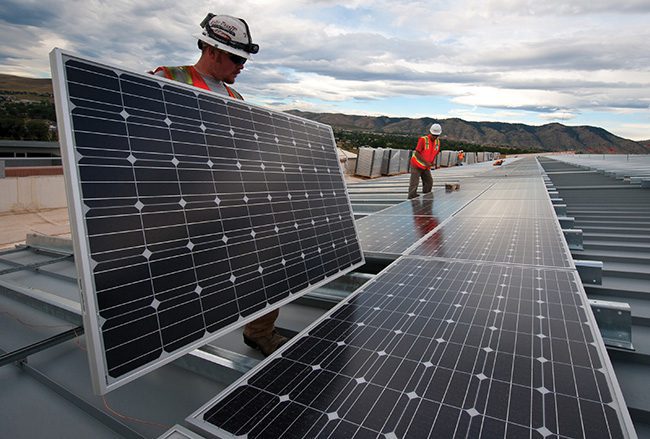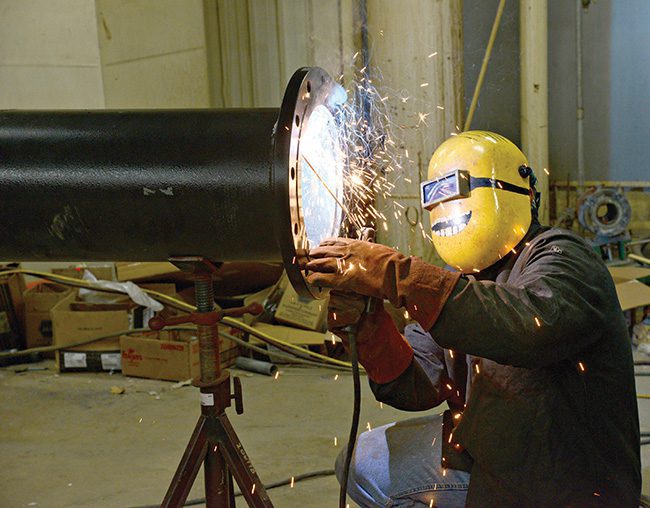The continuing transition in the power generation sector means workers need new skills. The challenge for utilities and other power producers is finding the top talent at a time the labor pool is shallow.
Technology advances in how electricity is produced and distributed mean workers need new skillsets. Utilities face the challenge of retaining and retraining their workforce, and finding new employees in an increasingly competitive marketplace for engineers and others with high-tech backgrounds in an era of increased digitization.
The labor market for the energy sector was hit hard by the coronavirus pandemic. U.S. Department of Energy (DOE) data shows a nearly 10% drop in the number of jobs across electric power generation, transmission, distribution, and storage through summer 2021, a major decline after the sector had showed strong job growth over the previous five years.
Retaining workers also has been an issue exacerbated by the pandemic. Various groups have weighed in on that problem, with some surveys reporting more than 40% of employees in the past year have said they would consider changing jobs rather than continue with their current organization.
There are encouraging signs. The DOE data shows job growth in the battery storage and electric vehicle (EV) sectors, and also in renewable energy, particularly in wind generation. And jobs in the solar power field are expected to be prevalent, with the Bureau of Labor Statistics predicting 52% growth for solar installers (Figure 1) this decade.
 |
|
1. The U.S. Bureau of Labor Statistics last year said jobs for solar power equipment installers are expected to increase by 52% this decade. Source: U.S. Department of Energy |
“As utilities become more engaged in the clean energy economy, they will have new opportunities to attract young and transitional workers who are energized by the prospect of providing better access to distributed energy resources and clean energy,” said Laure-Jeanne Davignon, vice president—Workforce for the Interstate Renewable Energy Council (IREC). “Their current pool of talent can be leveraged to foster the workforce of tomorrow through mentoring, paired work, job shadowing, and other ‘work-to-learn’ programs. This is one way to ensure institutional and historical knowledge can be transferred to new workers.”
Those “jobs of tomorrow” in the power generation sector include positions in environmental engineering, waste management, and government and regulatory administration—along with more traditional engineering jobs, including industrial machinery mechanics, and electricians familiar with new systems for both home and business. Technicians also are needed to install and service renewable energy projects.
Davignon emphasized the importance of a workforce that can handle the growth of renewable energy. She told POWER that “an influx of new talent will help shape the new and innovative approaches needed to realize bold clean energy goals. The business of generating and distributing energy is fundamentally shifting, and utility workforce development will need to reflect that reality.”
Training Programs
Some companies have workforce development programs to support the power generation labor pool. Eaton, a multinational power management group that supplies electrical solutions that support power infrastructure, works with customers “in a variety of segments, including utilities,” said Dan Carnovale, director of Eaton Experience Centers (Figure 2), the company’s training facilities. Carnovale told POWER: “It’s no secret that energy delivery systems and sources are changing fast. Now and in the future, electrical infrastructure needs to do much more than receive power from the grid. New technologies will be essential to supporting more sustainable energy systems and more technical know-how will be critical to support changing energy systems.”
 |
|
2. Eaton Experience Centers “provide real-world experiential learning that both new workforce entrants and experienced professionals need to grow their skills,” according to the company’s director of those training facilities. Courtesy: Eaton |
Carnovale said the Experience Centers “provide real-world experiential learning that both new workforce entrants and experienced professionals need to grow their skills. Our education programs help industry veterans stay up to date on emerging technologies and enable new power industry professionals to have practical, hands-on experience needed to be successful in their new roles. More than 150,000 customers from around the world have attended our Experience Center training programs. Our teams in Pittsburgh and Houston have developed both hands-on and virtual courses.”
Eaton is among the companies providing what Carnovale called “immersive training” for engineers new to the power generation sector. “We’ve developed a utility-focused ‘Grid-U-Cation’ training program, enabling new people to the industry to understand the physical qualities of equipment in a safe training environment,” he said. “For experienced and early professionals who need to better understand how to apply newer technologies, programs like Power in Focus bring access to essential industry training online and on-demand—addressing a range of topics including how to connect renewables to the grid, microgrid and energy storage systems, and more,” he added.
Energy Secretary Jennifer Granholm recently said “a strong energy workforce is critical to the U.S. economic recovery post-pandemic,” and she said the Biden administration is committed to “robust investments… to supercharge the energy job market.” The DOE launched a new Office of Energy Jobs, and in late December said the agency would “deepen our engagement with labor leaders and ensure that the clean energy industry creates good-paying, union jobs and employs a workforce that looks like America.” Granholm said that includes “requiring innovations developed with DOE dollars be substantially manufactured in the U.S. We are also working to bolster the supply chain for clean energy under President Biden’s executive order through our research on batteries, critical minerals, EV manufacturing and interagency work.”
“Electrical power is at the heart of what makes our homes, businesses, and infrastructure work,” said Carnovale. “It’s essential to our lives and that won’t change. The new generation of industry professionals needs to understand that choosing a career in the power generation business is exciting. And with the electrification of transportation and shift to more renewable power sources, new categories of professional expertise are needed and will have staying power in the years ahead.”
While new expertise is needed, there still exists opportunity for more traditional jobs. There specifically remains a need for welders (Figure 3), so much so that the American Welding Society (AWS) recently announced it provided nine schools with a Welding Workforce Grant to advance their welder training facilities. AWS in 2021 awarded more than $2 million in grants and scholarships.
 |
|
3. The power generation industry has always had a need for welders, a situation that remains constant even as the electricity sector evolves. Source: U.S. Air Force |
“We applaud the dedication these nine locations have demonstrated in expanding their welding education programs and facilities,” said Monica Pfarr, executive director of the AWS Foundation. “Their commitment to the welding industry and cultivating the next generation of welding technicians and professionals through education is inspiring.”
Construction and Demolition
As much as workers are needed to build and operate new power generation facilities, there also is a need for a larger workforce to demolish closed power plants and remediate those sites. Total Wrecking and Environmental, a Tonawanda, New York–based industrial demolition and environmental abatement contractor, in partnership with the Washington, D.C.–based National Demolition Association, recently announced the results of a nationwide survey, focused on the need for workers to dismantle retired non-renewable energy power plants. The takeaway? About 70% of the 4,500 contractors surveyed said the current workforce is too small to meet demolition needs across the U.S., with a conclusion that the industrial demolition workforce needs to triple in size over the next decade.
“More than anything, this survey highlights the need for development, recruitment, and education. We need to create pipelines of young professionals so that we can train and build the dynamic workforce we need to meet ambitious goals,” said Frank Bodami, CEO of Total Wrecking. “But this is a problem we can’t wait for the next generation to solve. We need to unite the entire industry under a clearly defined company-agnostic curriculum, from the client to the customer to the workforce, which would go a long way in educating the industry as a whole about the necessity of demolition and the extraordinarily delicate processes that protect its safety and integrity.”
Bodami told POWER: “There is a labor shortage in general, and this industry is impacted as much as others are. We are often put in a position where contractors may need to stretch out a project to keep the quality personnel at the right job sites. The labor shortages are across every level of the project; subcontractors for example are experiencing shortages both in labor and supply chain. A job requires skilled subs like drivers, plumbers, electricians, etc., and when we experience these shortages delays occur. In order to maintain a safe project (safety and quality), a schedule may suffer due to a shortage in total project skilled labor.”
Workers are needed not only to decommission closed power plants, but also to remediate those sites. Several companies have taken lead roles in turning former power plant locations into community parks and recreational areas, along with projects to put renewable energy—such as solar power or energy storage—at a brownfield site, taking advantage of existing transmission infrastructure.
“Yes, there needs to be a focus on the redevelopment of alternative power sources in cases where the plant is brought offline and there isn’t going to be enough production on the grid,” Bodami said. “Because of the transmission lines and infrastructure in place, or the vast area that a power plant services, alternative power sources could be a good use of the property and can replace some of the potential production that may be lost if that power plant is brought offline.” Those projects require many workers, first to perform environmental cleanup work, and then to design and build the project.
“Now we have seen some of this start to happen and the interest level building but there needs to be more. There is a lot of space for people to get great jobs in this industry,” Bodami said. “There are now some small trade programs or construction management programs, but there is nothing very specifically tailored to making our field visible and attractive to young students who are looking to work hands-on… this relates back to the need for apprenticeships and internships, but parents and schools are the key. We need to get to the parents and show them the benefits of being in a niche blue-collar trade like demolition. If the parents know, the kids will start to learn.
“Let’s face it, our workforce is aging and baby boomers are retiring,” said Bodami. “Kids are being told to go to college to get a four-year degree in sales, marketing, or computer science, which are all important, but no one is learning and going to school for blue-collar work. Construction, electricians, plumbers, demolition… all the trades are diminishing.”
Solar, Energy Efficiency Workers Needed
The Solar Energy Industries Association has said the solar power workforce will need to almost quadruple to reach the Biden administration’s goal of 100% carbon-free electricity by 2035. Energy efficiency is another area expected to need more workers; according to a report from the Energy Futures Initiative and the National Association of State Energy Officials, 91% of employers said it was somewhat or very difficult to make new hires.
To that end, Texas-based CLEAResult recently announced the launch of an e-learning digital interface, offering on-demand training, weatherization techniques, and other energy efficiency tools for energy providers, businesses, and others. “For years, CLEAResult has been providing utilities with the necessary technical solutions needed to be responsive to the changing demands of energy consumers,” said Shannon Meserole, CLEAResult’s senior learning and development manager. “The launch of CLEAResult ATLAS Academy allows us to move classroom training directly into the hands of trade allies who are implementing energy efficiency solutions and to consumers using them so energy savings can be achieved across the board.”
Southwestern Electric Power Co. (SWEPCO) began using the Academy in February of last year. The program created e-learning solutions from CLEAResult specifically targeted for SWEPCO.
“Over the last 18 months, we’ve had to ensure that SWEPCO is not only offering customers the same safe and reliable service they’re used to under normal conditions, but that our service contractors have reliable access to the tools they need to succeed,” said Sherry McCormack, manager of energy efficiency and consumer programs with SWEPCO. “The streamlined tools within CLEAResult ATLAS Academy have given us the flexibility to keep developing a trained network of energy service professionals that our customers can always count on.”
U.S. government data shows that energy efficiency accounts for more than 2 million jobs. Those include positions as part of utility programs around appliance and device standards, and incentives and rebates for energy-saving programs for both homes and businesses.
Commissioners from Florida’s Hillsborough County in December approved $500,000 for utility worker training, through the county’s public schools and a local community college. Training opportunities are being offered to support plant management, along with wastewater and utility maintenance operations.
Diversity and Inclusion
Davignon said the power generation sector, and certainly utilities, should be looking at diversity and inclusion practices to tap the widest pool of available talent. “Mandates [to hire minorities] certainly have a role in ensuring a seat at the table for communities and populations who have disproportionately suffered from the pollution and other health and safety impacts of traditional power generation,” she told POWER. “However, mandates will need to include or be coupled with workforce training and technical assistance for workers and employers to ensure any diversity gains are supported by a workplace culture which fosters employee satisfaction and retention.”
Davignon said power generators should “focus on mission, not just profit,” when it comes to their workforce. “Provide a flexible work environment and support for women and other diverse workers,” she said. “Invest in significant, long-term relationships with training partners so you are in touch with your potential employees before they enter the workforce.”
The energy transition is providing new jobs that require new skills, and Carnovale said that despite workforce challenges, he is optimistic about the future. “I love what I do. Elevating the industry and helping people understand and solve energy problems is incredibly fulfilling work,” Carnovale said. “There’s never been a more exciting time to be in the power industry—as we transform energy systems to be more sustainable, resilient, and efficient. The biggest changes in more than a century are underway and it’s an extraordinarily electrifying time to be a power industry professional.”
—Darrell Proctor is a senior associate editor for POWER (@POWERmagazine).











